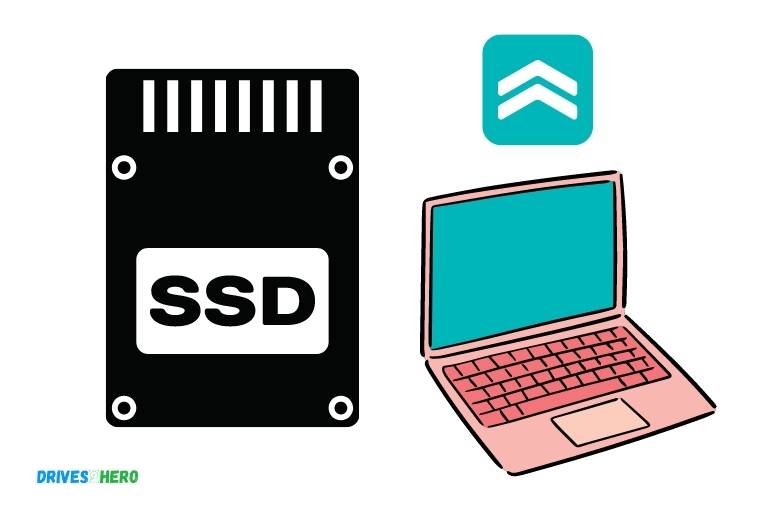Can You Upgrade Ssd on Laptop: A Comprehensive Guide
Yes, you can upgrade the SSD on a laptop by replacing the existing storage drive with a higher-capacity SSD.
Upgrading the SSD on a laptop involves removing the old storage drive, whether it is an HDD or an existing SSD, and installing a new SSD with a larger storage capacity.
This process not only increases the storage space but also improves the performance of the laptop, as SSDs are significantly faster than HDDs.
Before upgrading the SSD on your laptop, it is crucial to check the compatibility of the new SSD with your laptop’s specifications.
Make sure to consider factors such as the SSD form factor (M.2, SATA, or PCIe) and the physical dimensions of the drive.
Additionally, back up your important data before starting the upgrade process to avoid any data loss.
Upgrading an SSD on a Laptop
| Brand | Model | SSD Upgrade Possible | Notes |
|---|---|---|---|
| Dell | XPS 13 | Yes | Some models may require a special adapter |
| HP | Spectre x360 | Yes | |
| Lenovo | ThinkPad X1 | Yes | |
| Asus | ZenBook 13 | Yes | |
| Acer | Swift 5 | Yes | |
| Microsoft | Surface Laptop | No | SSD is not easily accessible |
| Apple | MacBook Pro | No | SSD is soldered to the motherboard |
| LG | Gram | Yes | |
| Razer | Blade Stealth | Yes | |
| MSI | Prestige 14 | Yes |
Key Takeaway

Five Facts About Upgrading an SSD on a Laptop
What Is Ssd?
Explanation Of Ssd
Solid-state drives (ssd) are a newer storage technology primarily used in laptops, smartphones, tablets, and other mobile devices.
They are a faster and more reliable alternative to hard disk drives (hdd) which are commonly found in traditional pcs.
How It Differs From Hdd
There are several key differences between ssd and hdd, including:
- Ssds have no moving parts, unlike hdds that use spinning magnetic disks. This means that ssds are less prone to mechanical failure and can perform faster read and write operations.
- Ssds are smaller and lighter than hdds. They are available in msata, m.2, and nvme form factors. M.2 ssds are the most common type found in laptops.
- Ssds consume less power than hdds, making them ideal for use in mobile devices with limited battery life. They also generate less heat which is important since laptops have limited cooling capabilities.
- Ssds are more expensive than hdds and typically offer less storage capacity. However, the prices have come down in recent years, and smaller ssds are now more affordable.
Ssds are a faster, more durable, and reliable alternative to traditional hdds. Upgrading a laptop’s hdd to an ssd can result in faster boot times, faster application load times, and a more responsive system overall.
Benefits Of Upgrading Ssd On Laptop
With advancements in technology, it’s easy to feel left behind by the ever-increasing speed and storage capacity offered by laptops.
However, upgrading your laptop’s ssd could be the solution, offering several benefits that enhance its overall performance.
Increase In Speed
By upgrading your ssd, you can expect a significant increase in speed, making your laptop much more efficient and productive.
Here are some key points:
- Faster boot-up times: Your laptop will start up in seconds, so you can begin working almost immediately.
- Improved application loading times: Applications will load much faster, enabling you to work more efficiently without any annoying delays.
- Faster read and write speeds: The ssd will enable faster data transfer, so you can transfer files between applications much more quickly, improving your productivity.
More Storage Space
Another benefit of upgrading your ssd is that it offers more storage space, which is essential if you have a large number of files, videos, and images.
Here are some key points:
- Increased storage: With a larger storage capacity, you can store more files and data, without worrying about running out of space.
- Streamlined installation: Upgrading your ssd requires minimum downtime, giving you a streamlined installation process.
Enhanced Overall Performance
Upgrading your laptop’s ssd not only increases speed and storage space but also improves its overall performance.
Here are some key points:
- Improved responsiveness: The laptop will operate much more efficiently, reducing lags and freezing up.
- Increased lifespan: Ssds have a longer lifespan than traditional hard drives, ensuring your laptop stays responsive and faster for longer periods.
- Boosted productivity: Faster speeds, more storage space and top-notch performance will improve your overall productivity, making it easier for you to handle large and complex projects.
By upgrading your laptop’s ssd, you can enjoy many benefits that significantly enhance its performance. So, what are you waiting for? Upgrade today and experience the marvel of modern technology!
Video On Can You Upgrade Ssd on Laptop
Compatibility
Checking If The Laptop Supports Ssd Upgrade
If you’re looking to upgrade your laptop’s storage space, upgrading to an ssd may be your best bet. It can offer faster boot times, quicker application launches, and improved overall performance.
But before you dive in to upgrade your laptop’s ssd, it’s important to check whether it supports an upgrade.
Here’s what you need to do:
- Check your laptop’s user manual or manufacturer’s website to determine whether it supports an ssd upgrade.
- Look for the type of ssd that your laptop supports – sata or pcie. You can also open your laptop to check the type of storage drive you already have.
- Check whether there is an available slot for your ssd. You can’t upgrade to an ssd if there is no open slot.
Identifying The Correct Sized Ssd For Your Laptop
If your laptop can support an ssd upgrade, the next step is to find the correct sized SSD.
Here’s what you need to do:
- Determine the size of the ssd slot in your laptop – 2.5-inch or m.2.
- Find out the size of your laptop’s existing drive. You can check this in your laptop’s storage settings or by opening the laptop and checking the physical drive.
Once you have determined the size of your ssd slot and your laptop’s existing drive, you can proceed to purchase an ssd with the correct size.
When it comes to upgrading your laptop’s ssd, it’s important to ensure compatibility with your laptop.
By checking whether your laptop supports an ssd upgrade and identifying the correct sized ssd, you can easily replace your laptop’s existing drive with a faster and more efficient ssd.
Warranty
Understanding The Impact On Laptop Warranty
Upgrading the ssd on your laptop can improve its performance significantly. However, it’s important to understand the impact on your laptop’s warranty before making any modifications.
Here’s what you need to know:
- When you upgrade the ssd on your laptop, you’re essentially opening up the device and making changes to it. This can void your laptop’s warranty, depending on the terms and conditions set by the manufacturer.
- Before you start the process, carefully read through your laptop’s warranty documentation. This will help you determine whether or not your warranty will still be valid after the upgrade.
- The warranty terms may specify that only authorized technicians or service centers can make hardware modifications to your device. Attempting a diy ssd upgrade could mean that you lose your warranty.
Remember, breaking your laptop’s warranty can prove costly in the long run if something goes wrong.
Consider the following points before making any ssd upgrades:
- Check if your laptop is still under warranty before performing any type of hardware upgrade.
- If your warranty is still valid, consult with the manufacturer or an authorized service center to see if they offer ssd upgrade services that won’t void your warranty.
- If your laptop is out of warranty, you can opt to upgrade the ssd yourself. Just be aware of the risks involved and the fact that you may lose any warranty coverage.
Now that you understand the potential warranty implications, you can make a more informed decision about upgrading the ssd on your laptop.
Backup Important Data
Can You Upgrade Ssd On Laptop
Do you have a laptop that has been slowing down? It can be frustrating, especially when you’re trying to get work done or binge-watch your favorite show.
Upgrading your laptop’s hard disk drive(hdd) to a solid-state drive (ssd) can be the solution you need to get your laptop running faster.
However, the thought of upgrading can be intimidating, especially when you’re dealing with important data. We’ll discuss how to upgrade an ssd on your laptop without losing your critical data.
Importance Of Backing Up Data
Before moving forward with upgrading your laptop to an ssd, you need to back up your critical data.
There are a few reasons why backing up your data is crucial:
- Accidents: It’s easy to spill a drink on your laptop or have an electrical surge, leading to hardware failure.
- Hdd damage: If your laptop has an hdd that’s malfunctioning, you may lose access to your data.
- Cybercrime: Cybercriminals may encrypt or damage your data, making it impossible to regain access.
- Upgrading to ssd: While upgrading to an ssd can improve your system’s performance, it can be risky if done without a data backup.
Ways To Back Up Data
Now that you know how crucial backing up your files is, let’s discuss the ways you can do it.
Here are a few options:
External Hard Drives
One of the easiest ways to back up your data is to use an external hard drive. You’ll need to connect the external hard drive to your laptop and copy all the important files over.
There are multiple options available, and you can choose one that fits your budget and storage requirements.
Cloud Storage
Cloud storage is another option for backing up your data. You can use platforms such as google drive, dropbox, and onedrive. All you need to do is upload your important files, and they’re stored on the internet.
Cloud storage platforms offer several advantages, such as remote access, data synchronization, and file sharing.
Nas Devices
Network-attached storage (nas) devices are connected to your laptop with an ethernet cable.
You can backup files automatically or manually to keep your data safe, and they can be accessed from anywhere with an internet connection.
Backing up data before upgrading to an ssd is a wise move, and there are several ways to do it, such as external hard drives, cloud storage, or nas devices.
Now that you have backed up your important files, you can confidently proceed with upgrading to an ssd on your laptop.
Removing The Old Ssd
Upgrading the ssd on your laptop is a fantastic way to boost your computer’s performance and increase its lifespan.
However, before you can install a new ssd, you first need to remove the old one. This step can seem daunting, but it’s a lot easier than you might think.
We’ll walk you through how to remove the old ssd and what you should do with it afterward.
How To Remove The Old Ssd
Removing the old ssd is a relatively simple process.
Follow these steps, and you’ll have your old drive out in no time:
- Power down your laptop and unplug it from any power sources.
- Locate the old ssd. In most laptops, the ssd can be found near the bottom of the chassis and is secured by one or two screws.
- Use a screwdriver to remove the screws that are securing the ssd in place.
- Slightly lift the ssd at an angle to disengage it from the connector.
- Gently pull the ssd out of its slot, and be careful not to touch the golden connectors—doing so can harm the ssd with electrostatic discharge (esd).
- Once the old ssd is removed, put it aside in an anti-static bag to prevent esd.
What To Do With The Old Ssd
Now that you’ve removed the old ssd, you may wonder what to do with it.
Here are some options:
- Keep it as a backup: You can keep the old ssd as a backup for your system in case your new ssd fails or malfunctions. It will prove beneficial in data recovery and system restoration.
- Sell it: You can sell the old ssd online at a reduced price tag, but you will still need to make sure it is wiped clean of any data to avoid any personal information being obtained.
- Recycle it or donate it: You may recycle the old ssd, or if possible, donate it to a charity or non-profit organization.
Removing the old ssd is easy, and there are several options for what to do with it. Following these steps ensures a smooth transition to a new ssd without losing any data as well as keeping the environment clean.
Installing The New Ssd
Can you upgrade ssd on laptop? How to install a new ssd
Upgrading your laptop’s ssd is a great way to boost its performance and increase its storage capacity.
However, installing a new ssd may seem daunting, especially if you don’t have much experience with computer hardware. In this section, we will discuss the necessary steps to install a new ssd on your laptop.
How To Install A New Ssd
The following steps will guide you through the process of installing a new ssd on your laptop:
- First, shut down your laptop and unplug it from any external power source.
- Remove the back panel of your laptop to access the internals. Depending on your laptop make and model, you might need a screwdriver to remove the screws securing the back panel.
- Locate the existing ssd in your laptop. The ssd is usually a small rectangular-shaped device connected to the motherboard with a cable.
- Gently disconnect the cable from the existing ssd and remove it from the laptop.
- Take out the new ssd that you want to install.
- Connect the cable to the new ssd and gently slot it into the empty slot.
- Secure the ssd with the screws that were removed from the previous ssd.
- Replace the back panel of your laptop and secure it with the screws.
- Finally, turn on your laptop to ensure that the new ssd is being detected correctly.
Additional Tools Required
The following tools are required to install a new ssd on your laptop:
- Screwdriver: Depending on the make and model of your laptop, you may need a phillips or torx screwdriver to remove the screws securing the back panel.
- Anti-static wristband: It’s essential to wear an anti-static wristband to prevent any damage to your laptop from electrostatic discharge.
- Cloning software: If you want to transfer your existing data from your current ssd to the new ssd, you’ll need cloning software that comes with the new ssd, or you can download it from the manufacturer’s website.
- Usb enclosure: In case your new ssd doesn’t come with cloning software, you’ll need a usb enclosure to connect the new ssd to your laptop for cloning.
Installing a new ssd on your laptop may seem complicated, but following these instructions will help you upgrade your laptop’s storage capacity and performance with ease.
Initializing The New Ssd
Can You Upgrade Ssd On Laptop? Initializing The New Ssd
Upgrading your laptop’s ssd can help increase its storage capacity and overall performance. It is also a cost-effective alternative to buying a new laptop.
However, initializing the new ssd can be a daunting task if you are not familiar with the process.
We will provide you with step-by-step instructions on how to set up your new ssd and optimize its performance.
How To Set Up The New Ssd
To upgrade your laptop’s ssd, you need to first purchase a compatible ssd that meets your storage needs.
Once you have your new ssd, follow these steps to set it up:
- Turn off your laptop and disconnect the power source.
- Remove the back panel of your laptop to access the old ssd.
- Unscrew the old ssd and gently remove it from its socket.
- Insert the new ssd into the socket and screw it in place.
- Reattach the back panel of your laptop and reconnect the power source.
- Turn on your laptop and boot it up.
Congratulations, you have successfully installed a new ssd on your laptop! However, initializing the new ssd is essential to achieving optimal performance.
Initializing The Ssd For Optimal Performance
Initializing your new ssd involves formatting it, partitioning it, and setting it up for use.
Follow these steps to initialize your new ssd:
- Press the windows key + x and select disk management from the menu.
- Locate your new ssd from the list of disks, right-click it and select initialize disk.
- Select the partition style (mbr or gpt) and click ok.
- Right-click the unallocated space on the new ssd and select new simple volume.
- Follow the prompts in the new simple volume wizard to partition your ssd, assign a drive letter, and format it.
Your new ssd is now ready for use! However, you can further optimize its performance by tweaking a few settings.
Additional Tweaks For Optimal Ssd Performance
To ensure that your new ssd runs smoothly and at optimal speeds, you can make the following tweaks:
- Disable disk defragmentation – ssds do not need defragmentation like hdds, so disabling it can help prolong the lifespan of your ssd.
- Enable trim – trim helps optimize the performance of your ssd by cleaning up unused blocks of data in the background.
- Disable superfetch – superfetch preloads frequently used data into your ram, but it can slow down your ssd’s performance. Disabling it can help improve your ssd’s speed.
Upgrading your laptop’s ssd is a great way to increase its performance and storage capacity. By following the above steps, you can easily set up and initialize your new ssd for optimal performance.
Additionally, remember to make the necessary tweaks to ensure your new ssd runs smoothly and at optimal speeds.
Restoring Data From Backup
Can You Upgrade Ssd On Laptop: Restoring Data From Backup
An upgrade in a laptop’s ssd can enhance its system speed and performance. Upgrading the storage system can also help increase storage capacity to accommodate more data, files, and programs.
However, transferring data during the upgrade process can cause potential data loss.
This is where restoring data from backup comes in.
How To Restore Data
Restoring data from backup is a crucial step in ensuring your files and important data are not lost during the ssd upgrade process.
Here’s how to restore data from backup:
- First, connect your external hard drive or any other backup source that contains your files and data.
- Open the backup source and locate the files you want to restore
- Copy and paste the files to a new folder on your laptop’s desktop
- Once you’ve pasted all the relevant files, you can disconnect the backup source.
Checking If All Data Is Restored Correctly
This step is equally important because restoring data does not imply successful data transfer.
Here’s how to ensure all data is correctly restored after the upgrade:
- Check each file and confirm it is still in its original format, is accessible and can be opened.
- Ensure all data and files are in their respective folder directories
- Cross-check the number of files you have restored and confirm that none are missing.
By following these simple steps, you can have your laptop running at maximum speed and performance, without the stress of losing any important files or data.
Frequently Asked Questions Of Can You Upgrade Ssd On Laptop
Can I Upgrade My Laptop’S Ssd?
Yes, upgrading your laptop’s ssd is possible with a few considerations such as the compatibility with your laptop’s hardware.
What Are The Benefits Of Upgrading My Laptop’S Ssd?
Upgrading your laptop’s ssd can significantly increase its overall performance such as faster boot time, quicker application loading, and better file transfer rates.
Is It Easy To Upgrade My Laptop’S Ssd?
Upgrading your laptop’s ssd can require some technical knowledge, but with helpful guides and tutorials, it can be a simple process.
What Factors Should I Consider Before Upgrading My Laptop’S Ssd?
You should consider your laptop’s compatibility with the new ssd, the size of the required storage, and the cost of the upgrade before making any decisions.
Conclusion
Upgrading your laptop’s ssd can significantly improve its overall performance and speed.
Whether you’re a gamer, a graphic designer, or work with large files, an ssd upgrade can help you accomplish tasks faster and more efficiently.
Before making a purchase, ensure that your laptop is compatible with the new ssd and understand the installation process.
Consider the storage capacity you need and choose a reliable brand with good reviews. Upgrading your ssd might seem daunting at first, but with proper research and execution, it’s a worthwhile investment.
You don’t have to replace your entire laptop to enjoy better performance; a simple upgrade could make all the difference.
So don’t wait, start exploring your options and take your laptop to the next level.






